
1
WARNING: Because of the possible danger to person(s) or property
from accidents which may result from the improper use of products,
it is important that correct procedures be followed. Products
must be used in accordance with the engineering information
specified in the catalog. Proper installation, maintenance and
operation procedures must be observed. The instructions in the
instruction manuals must be followed. Inspections should be made
as necessary to assure safe operation under prevailing conditions.
Proper guards and other suitable safety devices or procedures, as
may be desirable, or as may be specified in safety codes should be
provided, and are neither provided by Baldor Electric Company, nor
are the responsibility of Baldor Electric Company. This unit and its
associated equipment must be installed, adjusted and maintained
by qualified personnel who are familiar with the construction and
operation of all equipment in the system and the potential hazards
involved. When risks to persons or property may be involved, a
holding device must be an integral part of the driven equipment
beyond the speed reducer output shaft.
DODGE
®
PARA-FLEX
®
Couplings
Includes ATEX Approved Couplings
These instructions must be read thoroughly before installation or operation. The instruction manual was correct at the time of printing. Please see
www.dodge-pt.com for updated instruction manual.
WARNING: To ensure that drive is not unexpectedly started, turn
off and lock out or tag power source before proceeding. Failure to
observe these precautions could result in bodily injury.
WARNING: All products over 25 kg (55 lbs) are noted on the shipping
package. Proper lifting practices are required for those products.
FLANGE INSTALLATION
Two-Piece Flange Styles
PX40 STANDARD TAPER-LOCK
Flange
Internal
Clamp Ring
Flexible
Element
B
Flexible
Element
Flange
Internal
Clamp Ring
PX140 thru 320 TAPER-LOCK
Flexible
Element
Flange
External
Clamp Ring
B
B
B
B
PX50-120QD FLANGE ASSEMBLY PX140-200QD FLANGE ASSEMBLY
Figure 1 - Two-Piece Flange Styles
1. For the TAPER-LOCK
®
and QD anges, install bushing in the ange
per instructions included with bushing or nd the instruction
manuals at www.dodge-pt.com.
2. Check the axial oat of the shafts. Position the shafts at the mid-
point of the oat. Where Limited End Float is required or Sleeve
Bearings are used, consult DODGE for application assistance.
3. Referring to Figure 1 and Table 1, observe the “B” dimension for
the coupling size being installed. Mount and position the anges on
the shafts so that dimension “B” is achieved when the shafts are in
their nal position.
For the TAPER-LOCK and QD anges, secure the ange assembly
to the shaft by positioning the assembly onto the shaft allowing for
small axial movement which will occur during tightening procedure.
Alternately torque hardware to recommended torque setting. For
the clearance t straight bore (FBX) ange, tighten the set screws
to values listed in Table 2. Align anges using precision equipment
such as dial indicators or laser equipment.
If precision equipment is not available, scales, straight edges,
and calipers can be used as less accurate means of alignment. If
using a scale or calipers, refer to Figure 3 and check the angular
misalignment by measuring dimension “B” at four places 90° apart.
Adjust the equipment until the four measurements do not vary more
than value “C” in Table 1. If using a straight edge, check the parallel
offset by laying the straight edge across the outside diameter of
the anges in four places 90° apart. The gap between the ange
and straight edge should not exceed 1/32” (0.79mm). To achieve
maximum coupling performance, align the coupling as accurately
as possible during initial installation.
4. Remove any anti-rust lubricants or oil from the grooved side of the
clamp rings. Loosen but do not remove clamp ring screws until only
one or two threads are engaged and proceed to the section on
exible element installation.
Three-Piece Flange Styles
1. Disassemble the clamp rings from the anges. Place the external
clamp rings on the shafts with the grooved side facing the shaft
end.
2. For the TAPER-LOCK ange, install the bushing in the ange per
instructions included with bushing.
3. Check the axial oat of the shafts. Position the shafts at the mid-
point of the oat. Where Limited End Float is required or Sleeve
Bearings are used, consult DODGE for application assistance.
4. Referring to Figure 2 and Table 1, observe the “B” dimension for
the coupling size being installed. Mount and position the anges on
the shafts so that dimension “B” is achieved when the shafts are in
their nal position.
For the TAPER-LOCK ange, secure the ange assembly to the
shaft by positioning the assembly onto the shaft allowing for small
axial movement which will occur during tightening procedure.
Alternately torque setscrews to recommended torque setting. For
the clearance t straight bore (FBX) ange, tighten the set screws
to values listed in Table 2. Align anges using precision equipment
such as dial indicators or laser equipment.
If precision equipment is not available, scales, straight edges,
and calipers can be used as less accurate means of alignment. If
using a scale or calipers, refer to Figure 3 and check the angular
misalignment by measuring dimension “B” at four places 90° apart.
Adjust the equipment until the four measurements do not vary more
than value “C” in Table 1. If using a straight edge, check the parallel
offset by laying the straight edge across the outside diameter of
the anges in four places 90° apart. The gap between the ange
and straight edge should not exceed 1/32” (0.79mm). To achieve
maximum coupling performance, align the coupling as accurately
as possible during initial installation.
5. Remove any anti-rust lubricants or oil from the element side of the
clamp rings. Assemble clamp rings on the anges engaging only
one or two threads and proceed to the section on exible element
installation.
B
PX50-120 TL
B
PXFBS
B
PXBBS PXTBS
B
Flange
Flex
Internal
External
Figure 2 - Three-Piece Flange Styles
Figure 3 Figure 4

2
Table 1 - Mounting Dimensions
Coupling Size
Clamp Ring Screw Wrench Torque (lb-in)
Distance Between Flanges
B (in)
Total Difference
See Figure 8 (below)
C (in)
Flange Style
Two-Piece
Flange Style
Three-Piece
PX40 130 130 49/64 1/64
PX50 130 130 31/32 1/64
PX60 290 290 1-9/32 1/64
PX70 290 290 1-1/2 1/64
PX80 290 290 1-1/ 2 1/64
PX90 480 480 1-17/32 1/32
PX100 480 480 1-23/32 1/32
PX110 480 480 1-9/16 1/32
PX120 1080 1080 1-3/4 1/32
PX140 1080 1080 2-1/16 1/32
PX160 2160 1150 2-11/16 1/16
PX200 2160 2400 3-5/16 1/16
PX240 3600 4020 3-29/32 1/16
PX280 4320 6600 4-7/32 1/16
PX320 4320 6600 4-1/2 1/16
Coupling Size Clamp Ring Screw Torque (Nm)
Thread Size Flange Style
Two-Piece
Flange Style
Three-Piece
Distance Between
Flanges "B" (mm)
Total Difference
"C" (mm)
PXM 40 M6 15 15 19.4 0.4
PXM 50 M6 15 15 24.6 0.4
PXM 60 M8 36 36 32.5 0.4
PXM 70 M8 36 36 38.1 0.4
PXM 80 M8 36 36 3 8.1 0.4
PXM 90 M10 72 72 38.9 0.8
PXM 100 M10 72 72 43.7 0.8
PX M 110 M10 72 72 39.7 0.8
PXM 120 M12 125 125 44.5 0.8
PXM 140 M12 125 125 52.4 0.8
PXM 160 M16 311 130 68.3 1.6
PXM 200 M16 311 271 8 4.1 1.6
Table 2 - Set Screw Torque
Inch Set Screw Size #0 #1 #2 #3 #4 #5 #6 #8 #10 1/4 5/16 3/8 7/16 1/2 9/16 5/8 3/4 7/8
Torque (lb-in) 1 1.8 1.8 5 5 10 10 20 36 87 165 290 430 620 1325 2400 5200 7200
Torque (Nm) 0.1 0.2 0.2 0.6 0.6 1.1 1.1 2.3 4.1 9.8 18.6 32.8 48.6 7 0.1 149.7 271.2 5 87.5 813.5
Metric Set Screw Size M4 M5 M6 M8 M10 M12 M16 M20
Torqe (in-lbs) 19 35 64 150 290 480 1190 2100
Installation Torque (Nm) 2.2 4 7. 2 17 33 54 134 237
NOTE: Many sizes of PARA-FLEX elements are supplied with a
cardboard gauge to facilitate accurate flange spacing before
installing the rubber tire element. This gauge comes in the box
with the element. Gauges not supplied for PX40 and PX140 through
PX320. Gauges should not be used for alignment purposes.
FLEXIBLE ELEMENT INSTALLATION
1. Clean ange mounting area as well as surface that will come in
contact with the element with a solvent, such as Xylene (Xylol), to
remove grease, oil, wax, and dirt from surfaces. Do not clean the
element with the solvent. A diluted soapy water solution may be
applied to aid with element installation.
2. Wrap exible element around anges as shown in Figure 5. Make
sure beads of element are fully worked down upon the seats. To
ensure proper seating, tap around the tire’s outside diameter with
a small mallet until split is closed. Make sure element is evenly
centered on the anges.
3. Hold split of exible element closed as shown in Figure 6. Tighten
(nger tight) one or two screws 180° from split. Using both hands,
knead the tire pulling it toward the split. Hold split closed and
tighten (nger tight) the next two screws farthest from the split.
Repeat the procedure on all remaining clamp ring screws. Use a
torque wrench to tighten each clamp ring screw in succession to
the torque specied in Table 1. Using a torque wrench, recheck all
clamp ring screw torque values before coupling operation.
4. Optional Procedure: Hold split of exible element closed as shown
in Figure 6. Tighten (nger tight) one or two screws 180° from split.
Using both hands, knead the tire pulling it toward the split. Hold
split closed and tighten (nger tight) the next two screws in a star
or cross pattern as shown in Figure 7. Repeat the procedure on all
remaining clamp ring screws. Use a torque wrench to tighten each
screw to the torque specied in Table 1. Using a torque wrench, re-
check all clamp ring screw torque values before coupling operation.
5. Install coupling guards per OSHA or applicable requirements.
Guarding should be designed so that coupling tyre will be contained
wihtin the guard in the event that the coupling tyre is thrown from
the coupling assembly.
3
1
8
6
4
2
7
5
Figure 5 Figure 6 Figure 7

3
FLEXIBLE ELEMENT REPLACEMENT
Loosen all clamp ring screws. Grasp one end of exible element at the
split and peel off the anges. Clean clamping parts with a solvent, such
as Xylene (Xylol), to remove grease, oil, wax, and dirt from surfaces. Do
not clean element with solvent. Check to see that only one or two threads
of each clamp ring screw are engaged. Re-align anges and install new
exible element according to the sections on ange installation and
exible element installation. When replacing clamp ring screws and
washers, use only SAE Grade 8 or ISO Class 10.9 screws and hardened
washers.
WARNING: The metal components of the coupling that clamp
the flexible element will operate properly only if the screws are
tightened properly. Tightening one screw to full torque before
proceeding to the next screw may cause excessive clamp ring or
flange deflection. To prevent clamp ring and flange deflection, the
screws must be evenly and gradually tightened to full torque.
FLOATING SHAFT COUPLING INSTALLATION
Piloted Internal
Clamp Ring
Assembly
BBPS x BBPS
BBPS x TBPS
TBPS x TBPS
Flexible
Element
Floating
Shaft Bearing
Assembly
FLG. to FLG. Distance
F/S FLG. to FLG. Distance
BPS
Flange
BCS
Flange
External
Clamp Ring
BB
Figure 8 - Floating Shaft Coupling
1. Disassemble the clamp rings from the anges. Place the external
clamp rings on the shafts with the grooved side facing the shaft
end.
2. Check the axial oat of the shafts. Position the shafts at the mid-
point of the oat. Where Limited End Float is required or Sleeve
Bearings are used, consult DODGE for application assistance.
3. Referring to Figure 8 and Table 1, observe the “B” dimension for the
coupling size being installed. Mount and position the anges on the
shafts so that dimension “B” is achieved when the shafts are in their
nal position. Where anges contain set screws, tighten to values
listed in Table 2.
4. Remove any anti-rust lubricants or oil from the grooved side of the
clamp rings. Assemble internal and external clamp rings to oating
shaft anges and snug up clamp ring screws. Slip internal piloted
clamp rings onto the turned down portion of oating shaft. Hub
projection on clamp ring should be toward oating shaft as shown
in Figure 8.
5. Position and support oating shaft assembly between driving
and driven anges. Make sure clamp ring pilot is seated in ange
counterbore. Assemble external clamp rings to ange with screws.
Tighten screws sufciently to prevent movement between the parts.
6. Align anges using precision equipment such as dial indicators or
laser equipment. If precision equipment is not available, scales,
straight edges, and calipers can be used as less accurate means of
alignment. If using a scale or calipers, refer to Figure 3 and check
the angular misalignment by measuring dimension “B” at four
places 90° apart. Adjust the equipment until the four measurements
do not vary more than value “C” in Table 1. Repeat the procedure
at both ends of the coupling. To achieve maximum coupling
performance, align the coupling as accurately as possible during
initial installation.
7. Loosen clamp ring screws and proceed to Section II for element
installation.
ATEX Approved PARA-FLEX Couplings
These instructions do not cover all details or variations in equipment nor
provide every possible contingency or hazard to be met in connection
with installation, operation, and maintenance. Should further information
be desired, or should particular problems arise which are not covered in
this manual, the matter should be referred to your local BaldorDodge
representative.
DODGE Elastomeric couplings are manufactured under the guidelines of
the ATEX directive 2014/34/EU.
DODGE Elastomeric couplings are suitable for ATEX category 2 and
M2, Group II and I for gas and dust environments and are also suitable
for ATEX category 3 for all gas or dust environments with ignition
temperatures higher than T5 = 100° C.
A sticker indicating ATEX certication will be attached to the product or
on the box containing the product and will be similar to the following:
OR
Figure 9 - ATEX Certification
WARNING: These couplings are designed to operate with surface
temperatures below 100°C when properly installed and selected.
Excessive temperatures greater than 80°C is a result of an abnormal
operating condition caused by:
1. Improper installation - refer to installation manual for
proper procedures
2. Excessive misalignment - re-align coupling / shafts
3. Failure of the coupling element - replace elastomeric
4. Excessive speed - re-evaluate application and selection
5. Excessive vibration - determine source, re-evaluate
application
If applied in a Division 1 or Zone 1 environment, the excessive
temperature may cause ignition of hazardous materials.
In hazardous environments, DODGE elastomeric couplings should not
be considered as fail safe or “break-away” power transmission devices.
Overloads imposed to these devices could cause irreparable damage,
shall be considered an explosive hazard, could create projectiles, and/
or could cause torque transmission interruptions. The coupling shall be
sized and used to the stated torque capabilities of the unit as published
in the DODGE PT Components Engineering Catalog. Any assistance
needed in selection shall be referred to a BaldorDodge representative.
Additional Instruction for Safe Installation and Use
1. All rotating parts should be guarded to prevent contact with foreign
objects which could result in sparks, ignition, or damage to the
coupling.
2. Couplings should be periodically inspected for normal wear,
dust/dirt buildup or any similar scenario that would impede heat
dissipation.
3. Increasing levels of vibration and noise could indicate the need for
inspection, repair or replacement of the coupling or element.
4. Electrical sparks are a source of ignition. To reduce the risk, proper
electrical bonding and grounding is recommended.
5. Overloading may result in breakage or damage to the coupling
or other equipment. As a result the coupling could become an
explosion hazard. Damaged coupling components or elements
must not be operated in hazardous environment.
6. If thrust loading or axial movement is anticipated, The DODGE
PARA-FLEX coupling is the desired unit for use as it has design
capability of accepting this movement up to 5/16”. Couplings are
not intended to be used as thrust bearing members.
7. Coupling guards should have a minimum of 2” clearance over
PARA-FLEX tire style couplings. (3” clearance for PARA-FLEX style
couplings greater than 16” outer diameter.)
8. The date code should be read as:
14
Indicates
Year
Indicates Month
(one dot per
month)

P.O. Box 2400, Fort Smith, AR 72902-2400 U.S.A., Ph: (1) 479.646.4711, Fax (1) 479.648.5792, International Fax (1) 479.648.5895
Dodge Product Support
6040 Ponders Court, Greenville, SC 29615-4617 U.S.A., Ph: (1) 864.297.4800, Fax: (1) 864.281.2433
www.baldor.com
All Rights Reserved. Printed in USA.
07/16 Litho 20,000
© Baldor Electric Company
MN4027 (Replaces 499710)
Document Control Number: DOC-BEZ-DA-M22-C-EN.DOC 1 / 1
EU Declaration of Conformity
The undersigned, representing the following supplier and the following authorized representative-
Baldor Electric Company
5711 R. S. Boreham, Jr. Street
Fort Smith, Arkansas 72901 USA
ABB Automation Products GmbH
Oberhausener Straße 33
40472 Ratingen, Germany
This declaration is issued under the sole responsiblity of the manufacturer.
herewith declare that the Products
Couplings
Product identification (brand and
catalogue number/part number):
Dodge Paraflex, Dodge D-Flex Equipment Group I, Category M2
c / Equipment Group II Category 2 GD c T5 T amb - 30°C to
+50°C
are in conformity with the provisions of the following EC Directive(s) when installed in accordance with the installation
instructions contained in the product documentation:
94/9/EC and 2014/34/EU
1
ATEX
Note 1: 94/9/EC applies until April 19, 2016, 2014/34/EU applies from April 20, 2016
and that the standards and/or technical specifications referenced below have been applied:
EN 13463-1:2009 Non - Electrical Equipment For Potentially Explosive Atmospheres -Method And
Requirements
EN 13463-5:2011 Non - Electrical Equipment For Potentially Explosive Atmospheres – Part 5
Protection by constructional safety ‘c’
Notified Body:
Sira Certification Services Ltd
Unit 6
Hawarden Industrial Park
Hawarden
DEESIDE
CH5 3US
Certificate: SIRA 04ATEX9358
Supplier: Authorised Representative:
Signature
Signature
Name: L. Evans Massey Name: Michael Klein
Position: Manager Standards and Certification Position: Regional Sales and Marketing Manager Central
Europe
Date: 1 April 2016 Date: 1 April 2016
*4027-0716*
-
 1
1
-
 2
2
-
 3
3
-
 4
4
Dodge Para-flex Couplings: Includes ATEX Approved Couplings Owner's manual
- Type
- Owner's manual
- This manual is also suitable for
Ask a question and I''ll find the answer in the document
Finding information in a document is now easier with AI
Related papers
-
Dodge Ribbed Rigid Couplings Owner's manual
-
Dodge Short Series Brake Motors Owner's manual
-
Dodge Tigear 2 Accessory Kit Operating instructions
-
Dodge Tigear 2 Accessory Kit Operating instructions
-
Dodge Poly-Disc Couplings Owner's manual
-
Dodge Bronzoil Bearings Owner's manual
-
Dodge ATEX Approved Para-Flex and D-Flex Couplings Operating instructions
-
Dodge GFB User manual
-
Dodge Torque Arm Reducers Owner's manual
-
Dodge ATEX Approved DODGE® Ball & Roller Bearings Operating instructions
Other documents
-
Sentinel PXM-2 User manual
-
Eaton Power Xpert Meter 1000 Owner's manual
-
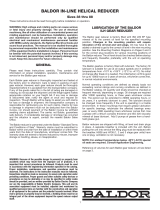 Baldor-Reliance In-Line Helical Reducer Owner's manual
Baldor-Reliance In-Line Helical Reducer Owner's manual
-
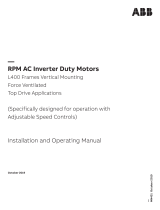 Baldor-Reliance RPM AC Inverter Duty Motors L400 Frames Vertical Mounting Owner's manual
Baldor-Reliance RPM AC Inverter Duty Motors L400 Frames Vertical Mounting Owner's manual
-
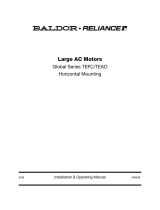 Baldor-Reliance Large AC Motors Global Series TEFC/TEAO Horizontal Mounting Owner's manual
Baldor-Reliance Large AC Motors Global Series TEFC/TEAO Horizontal Mounting Owner's manual
-
Baldor 11C User manual
-
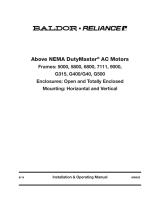 Baldor-Reliance Above NEMA DutyMaster AC Motors (Horizontal & Vertical) Owner's manual
Baldor-Reliance Above NEMA DutyMaster AC Motors (Horizontal & Vertical) Owner's manual
-
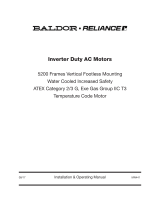 Baldor-Reliance Inverter Duty AC Motors Owner's manual
Baldor-Reliance Inverter Duty AC Motors Owner's manual
-
ITT Goulds Pumps LF 3196 i-FRAME Operating instructions
-
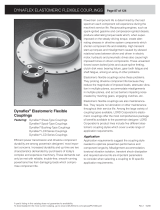 Dynaflex LCD User manual
Dynaflex LCD User manual









